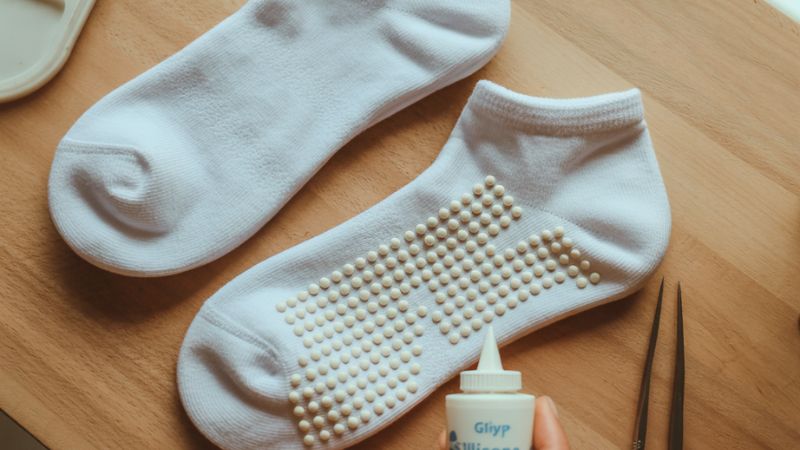Alpaca socks are generally considered warmer than wool socks. However, it’s important to note that both alpaca and wool socks have their merits, and the choice often comes down to personal preference and specific needs.
Let’s dive into these differences to make a good choice for keeping your feet warm in the coming winter.
What is Wool Fiber?
Wool fiber originates from a variety of animals, but the most common sources are sheep and goats. Merino wool, mohair, and lamb wool are all distinct types of wool.
When it comes to sheep wool, there are distinct types based on breed and age.
Merino wool, derived from Merino sheep, stands out as the finest type. It is prized for its unparalleled softness, comfort, and luxurious feel, making it a favorite for high-end garments.
On the other hand, Lamb wool refers to the wool from young sheep (lambs). It is generally softer and finer than wool from adult sheep of the same breed, making it ideal for delicate garments.
Lastly, ordinary sheep wool, which encompasses wool from common sheep breeds excluding Merino, is typically coarser and less fine than Merino wool. While still useful, it is often used in heavier garments like coats or in blends with other fibers.
When it comes to goat wool, mohair stands out as the finest type. This luxurious fiber comes from Angora goats and is renowned for its silky texture, luster, and durability. It is often used for high-end clothing and upholstery.
Ordinary goat wool, on the other hand, is generally too coarse and short-fibered for clothing applications. It is mainly utilized in non-clothing applications like brushes, carpets, or industrial uses.
What is Alpaca Wool?
Alpaca fiber is derived from alpacas, domesticated South American camelids related to llamas, not sheep or goats.
Typically, alpaca fiber comes in two main types: huacaya (crimpy and fluffy) and Suri (silky and straight).
Huacaya alpacas, which constitute approximately 85% of the alpaca population, are noted for their larger body size. Their fleece exhibits a coarse, long wool-like sheen, with fiber fineness comparable to that of Merino sheep wool. Due to their prevalence, Huacayas are widely bred and boast high production rates.
In contrast, Suri alpacas are less common and have a smaller body frame. Their fiber is straight, dense, and smooth, similar to that of Angora goats. Suri fleece is known for its softness and longer staple length and is available in various colors, including white, gray, black, and brown.
The fibers possess a silk-like sheen reminiscent of young mohair, with a fineness ranging from 15 to 20 microns. Suri alpacas have fewer coarse guard hairs compared to Huacayas. Their down fibers, which lack a medulla, typically measure 8 to 12 centimeters in length, while the guard hairs containing a medulla can extend up to 30 centimeters.
Why are Alpaca Socks Warmer than Wool Socks?
The main reason is that alpaca fibers have a unique hollow core structure, while sheep’s wool only contains air pockets. The hollow core of alpaca fibers allows them to trap more warm air, providing better insulation compared to wool.
However, there is no single standard that definitively states which type of socks is objectively “the best” since products made by one single material is less common in the market. Most products are blends, combining wool or alpaca with other natural or synthetic fibers to enhance specific properties or reduce costs.
For consumers, checking factors like fiber quality, wool content, and certifications can help to make informed choices.
Here is a table for you to fully understand the parameters of alpaca and wool, which take merino wool as an example:
| Characteristic | Alpaca | Merino Wool |
|---|---|---|
| Origin | Alpaca (camelid) | Merino sheep |
| Fiber Structure | Hollow core | Solid fiber |
| Softness | Smoother, less prickly | Very soft, but can be prickly |
| Warmth | Warmer due to hollow fibers | Very warm |
| Tensile Strength | Higher (around 50 N/ktex) | Lower (30-40 N/ktex) |
| Water Absorption | Lower (10-11% of weight) | Higher (about 30% of weight) |
| Drying Speed | Faster | Slower |
| Odor Resistance | Excellent | Very good, but can retain odors over time |
| Allergenicity | Hypoallergenic (no lanolin) | Contains lanolin (potential allergen) |
| Environmental Impact | More sustainable | Less sustainable |
| Durability | Very durable | Durable, but less than alpaca |
| Elasticity | Less elastic | More elastic |
| Typical Fiber Diameter | 18-25 microns | 11-24 microns |
| Natural Colors | More Variety | Fewer options |
| Availability | Less common | More widely available |
| Cost | Generally more expensive | Generally less expensive |
| Care | Easier to launder | Can be prone to felting if not treated |
Frequently Asked Questions
Which fiber is more eco-friendly: alpaca fiber or merino wool?
While both fibers have eco-friendly qualities, alpaca appears to have a slight edge in sustainability due to its lower environmental impact, more efficient production, and minimal processing requirements.
Does alpaca wool have more moisture wicking than wool?
Alpaca absorbs only about 10-11% of its weight in moisture; wool (including Merino can absorb up to 30-50%.
Alpaca fiber has a unique moisture management property. While it doesn’t wick much moisture away by itself, it efficiently facilitates the evaporation of moisture around it. This characteristic creates a microclimate that adapts to your body’s needs.
Is alpaca breathable?
Yes, alpaca wool is highly breathable.
Is alpaca more itchy than wool?
No, alpaca wool is typically less itchy than wool. Alpaca fibers have smaller, flatter scales that sit closer to the fiber surface, and alpaca wool contains little to no lanolin, which is generally considered good for sensitive skin.
What is cashmere wool?
Cashmere is renowned for its softness, warmth, and luxurious feel, making it a highly sought-after material in the fashion and textile industries, better than alpaca and wool.
Is alpaca biodegradable?
Pure alpaca wool is indeed biodegradable, making it an environmentally friendly choice for clothing and textiles.



